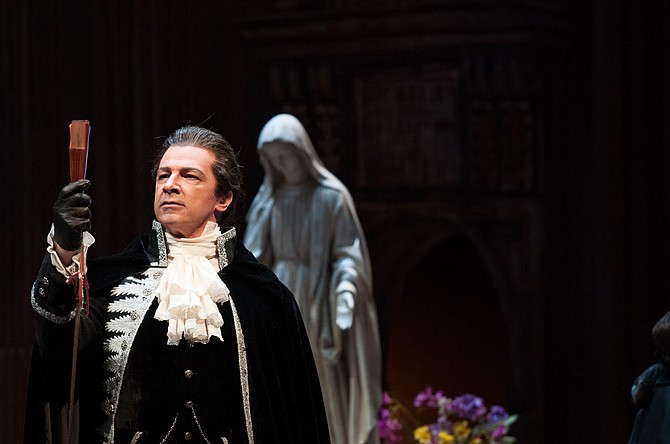 Facebook
Facebook
 X
X
 Instagram
Instagram
 TikTok
TikTok
 Youtube
Youtube

San Diego Opera has started their season of transition with Tosca by Puccini. It should be noted that all three productions this year were established by the previous regime. This season is not an indication of what is to come but rather a reflection of what has past.
The great thing about Tosca is the villain Scarpia. Should we doubt that he is the central figure, the final line of the show is about him.
American bass-baritone Greer Grimsley portrays the heartless Baron Scarpia in a January 2015 production of Tosca.
The great thing about this particular production of Tosca is Greer Grimsley singing the role of Scarpia. He is one of the few singers to have ever lived that can cut through the menacing orchestral forces which accompany Scarpia’s music.
Grimsley dominates the stage at all times as is appropriate for an abusive, sadistic, cunning, monster. He’s a politician who doesn’t need your vote.
The orchestra, as conducted by the atomic Massimo Zanetti, was spectacular. The third act transition from the tenor aria to Tosca’s entrance was nothing short of a miracle with the grace note in the strings in perfect alignment with the emotion of the scene.
The music harkens back to the first act duet where, it must be pointed out, tenor Gwyn Hughes Jones inexplicably did not sing the grace notes. It might feel as though I’m making quite a lot of noise about grace notes, but they are one of the details in the score which makeTosca...Tosca.
Whereas Grimsley is a full-time Scarpia, Jones is a stretch in the role of Mario Cavaradossi. The color of Jones’s voice is on the bright side for Cavaradossi. He has a beautiful voice should we listen with a casual ear, but there are some vowel production inconsistencies that we won’t get into here.
Soprano Alexia Voulgaridou is also a stretch as a Tosca. The color and tone of her voice were in line with this spinto role until about an A-flat, at which point the tone spread and the color changed. Her acting was okay but Tosca’s sexual allure was missing.
The direction of Lesley Koenig was conventional and at times boring. There was a lack of sexual tension in the acting and the staging. The violence was also absent. Cavaradossi came out from his torture session wearing a spotless white shirt without a scratch on him.
They must have been using "the comfy chair" as a torture device a la Monty Python's Spanish Inquisition.


San Diego Opera has started their season of transition with Tosca by Puccini. It should be noted that all three productions this year were established by the previous regime. This season is not an indication of what is to come but rather a reflection of what has past.
The great thing about Tosca is the villain Scarpia. Should we doubt that he is the central figure, the final line of the show is about him.
American bass-baritone Greer Grimsley portrays the heartless Baron Scarpia in a January 2015 production of Tosca.
The great thing about this particular production of Tosca is Greer Grimsley singing the role of Scarpia. He is one of the few singers to have ever lived that can cut through the menacing orchestral forces which accompany Scarpia’s music.
Grimsley dominates the stage at all times as is appropriate for an abusive, sadistic, cunning, monster. He’s a politician who doesn’t need your vote.
The orchestra, as conducted by the atomic Massimo Zanetti, was spectacular. The third act transition from the tenor aria to Tosca’s entrance was nothing short of a miracle with the grace note in the strings in perfect alignment with the emotion of the scene.
The music harkens back to the first act duet where, it must be pointed out, tenor Gwyn Hughes Jones inexplicably did not sing the grace notes. It might feel as though I’m making quite a lot of noise about grace notes, but they are one of the details in the score which makeTosca...Tosca.
Whereas Grimsley is a full-time Scarpia, Jones is a stretch in the role of Mario Cavaradossi. The color of Jones’s voice is on the bright side for Cavaradossi. He has a beautiful voice should we listen with a casual ear, but there are some vowel production inconsistencies that we won’t get into here.
Soprano Alexia Voulgaridou is also a stretch as a Tosca. The color and tone of her voice were in line with this spinto role until about an A-flat, at which point the tone spread and the color changed. Her acting was okay but Tosca’s sexual allure was missing.
The direction of Lesley Koenig was conventional and at times boring. There was a lack of sexual tension in the acting and the staging. The violence was also absent. Cavaradossi came out from his torture session wearing a spotless white shirt without a scratch on him.
They must have been using "the comfy chair" as a torture device a la Monty Python's Spanish Inquisition.
Comments